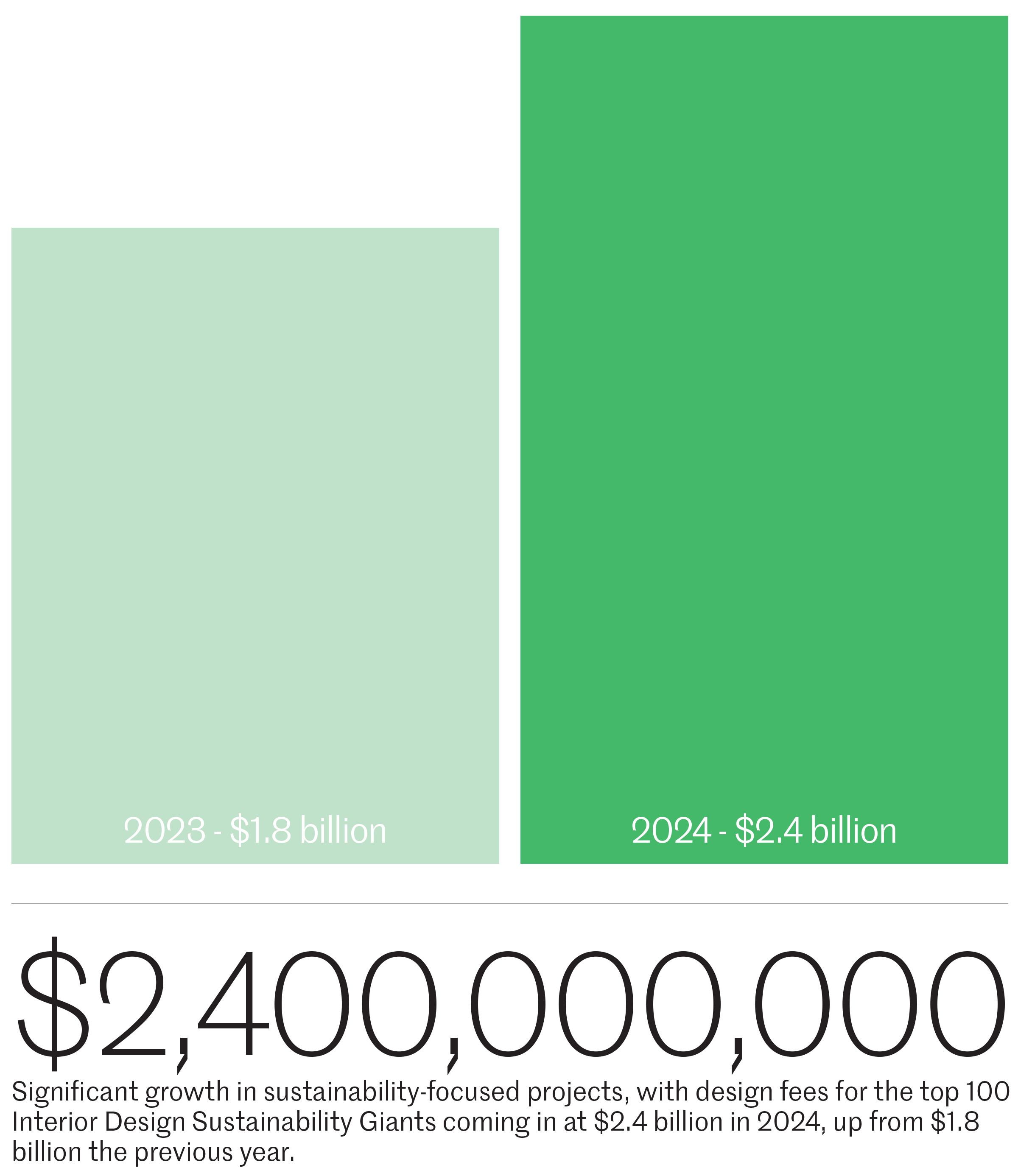
September 10, 2024
How Firms Are Putting Sustainability Into Practice
As climate change poses unprecedented challenges, the interior design industry is stepping up, embracing sustainability not just as a trend but as a necessity. New 2024 research shared by INTERIOR DESIGN magazine and analyzed by ThinkLab reveals a significant growth in sustainability-focused projects, with design fees for the top 100 Interior Design Sustainability Giants coming in at $2.4 billion in 2024, up from $1.8 billion the previous year.
Carbon Conscious
A key aspect of this transformation is the industry’s increased attention to embodied carbon. Firms like AECOM are at the forefront, leading the charge in the number of projects scrutinizing their carbon footprint. And industry-wide, the number of projects tracking embodied carbon rose from 5 to 7 percent between 2022 and 2023.

LEED and WELL Hold Steady
Leadership in achieving certifications like WELL and LEED is becoming a badge of honor among firms, but the percentage of clients achieving these certifications has remained unchanged year after year. The rate of staff holding LEED or WELL AP accreditations also remains steady at 24 percent, reflecting a robust yet unchanging commitment to expertise in sustainable design.
Firms like Partners by Design and Clark Nexsen lead the pack in these areas, showcasing the industry’s dedication not only to healthy buildings but also to the health and well-being of those who occupy them. And remarkably, nearly half (48 percent) of furnishings and finishes are now chosen for their sustainability credentials, highlighting a broader industry shift toward materials and products that support a healthier planet.
Certification Hesitation
However, the journey toward sustainability is not without hurdles. While more projects align with sustainable principles, there’s a noticeable rise—from 27 to 37 percent—in clients who are reluctant to foot the bill for certifications. Despite this, firms such as Perkins&Will are making notable strides, with an impressive 90 percent of their projects tracking to sustainable fees, demonstrating that commitment to sustainability can indeed coexist with financial viability.
Client Demand & ESG
Twenty-nine percent of clients consider environmental, social, and governance (ESG) goals as pivotal to their design projects, a figure that holds steady from the previous year. This interest in ESG underscores a growing consensus on the importance of sustainable design principles in meeting broader societal goals, but also remains lower than most practitioners would hope to see.
CannonDesign’s bold assertion that “shaping a more sustainable world may be the greatest challenge of our time, and we are ready for the fight,” encapsulates the industry’s resolve. Firms across the board are not just adapting to sustainability; they are redefining their practices around it.
As the industry’s efforts show, the path to a more sustainable future is not just possible but is already under way—one space at a time.
Would you like to comment on this article? Send your thoughts to: [email protected]
Latest
Profiles
Zoha Tasneem Centers Empathy and Ecology
The Parsons MFA interior design graduate has created an “amphibian interior” that responds to rising sea levels and their impacts on coastal communities.
Viewpoints
How Can We Design Buildings to Heal, Not Harm?
Jason McLennan—regenerative design pioneer and chief sustainability officer at Perkins&Will—on creating buildings that restore, replenish, and revive the natural world.
Products
Behind the Fine Art and Science of Glazing
Architects today are thinking beyond the curtain wall, using glass to deliver high energy performance and better comfort in a variety of buildings.





